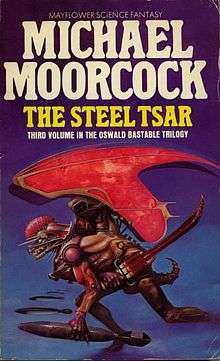The Steel Tsar
 Cover of the first edition by Melvyn Grant | |
| Author | Michael Moorcock |
|---|---|
| Cover artist | Melvyn |
| Country | United Kingdom |
| Language | English |
| Series | Oswald Bastable |
| Genre | Science fiction novel |
| Publisher | Granada |
Publication date | 1981 |
| Media type | Print (Paperback) |
| Pages | 155 pp |
| ISBN | 0-583-13432-7 |
| OCLC | 12404432 |
| Preceded by | The Land Leviathan |
The Steel Tsar is a sci-fi/alternate history novel by Michael Moorcock, first published in 1981 by Granada.[1] Being a sequel to Warlord of the Air (1971) and The Land Leviathan (1974), it is the final part of Moorcock's A Nomad of the Time Streams trilogy regarding the adventures of Captain Oswald Bastable and which has been seen as an early example of steampunk fiction.[2] The same cover image was used for the 1987 reissue of Judas Priest album Rocka Rolla and also the 1989 video game Ballistix.
Plot summary
In a story introduced by the ubiquitous Una Persson (who is also found in other works by Moorcock), the trilogy's hero, Captain Oswald Bastable, finds himself in an alternative twentieth century in which the Confederate States of America won the American Civil War and neither the First World War nor the October Revolution ever occurred. Over the course of the story Oswald witnesses the destruction of Singapore at the hands of the Imperial Japanese Aerial Navy, is imprisoned on Rishiri Island, joins the Russian Imperial Airship Navy and is sent to put down the rebellious Cossacks who follow the theocratic demagogue known as the 'Steel Tsar': Iosif Djugashvili. He also experiences a repeat of events from the first novel as he is assigned to drop an atomic bomb on the anarchist Nestor Makhno and his Black Flag Army, but ultimately this does not happen; the bomb is turned against the Steel Tsar's own forces and Makhno survives.
Themes
While imperialism and racism in nineteenth century "heroic" fiction were deconstructed in its predecessors, the final book of the trilogy deals with the benefits of socialism and anarchism in a third alternate twentieth century where there were no effective social democratic parties in Western Europe and Australasia, as in our world. Another notable feature of this installment of the series is the lack of conflict or tension between the Confederate States of America and the United States of America, both of whom have since settled their differences and become active trading partners and political/military allies.
References
- ↑ http://www.complete-review.com/reviews/moorcock/nomad3.htm
- ↑ Bebergal, Peter (2007-08-26). "The age of steampunk". The Boston Globe. Retrieved 2008-05-10.
External links
- "Internet Speculative Fiction Database". Retrieved 2007-12-18.
- "Moorcock's Miscellany". Retrieved 2007-12-18.
- Brown, Charles N.; William G. Contento. "The Locus Index to Science Fiction (1984–1998)". Retrieved 2007-12-18.
- Jacob, Merle; H. Apple (2000). To Be Continued: An Annotated Guide to Sequels. Greenwood Press. p. 199. ISBN 1-57356-155-X.